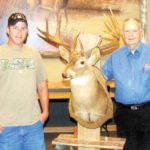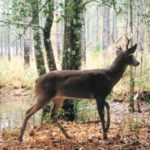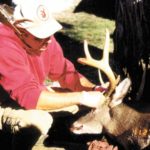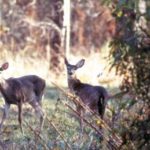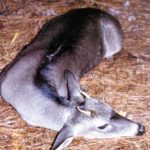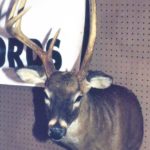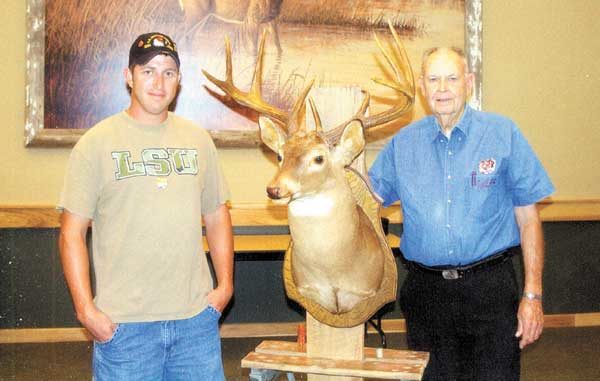
The 2008-09 deer season will be the fourth year for the Antler Restriction Program on Thistlethwaite. Is an Antler Restoration Program necessary on a WMA that has produced Boone and Crockett deer in the past?
At a recent deer-scoring event at Cabela’s in Gonzales, Joshua Babin of Prairieville brought in a buck that his grandfather killed on Thistlethwaite WMA in 1972.
Joe Herring, an official B&C measurer and a career LDWF biologist, was working the event with Czerney Newland, Scott Durham and me. Herring did the paperwork while I took the measurements.
The buck was impressive, and sported nine points, 26- and 24-inch main beams and a 24 2/8-inch inside spread.
The final B&C score was 144 typical. It was indeed a fine specimen, and I asked Herring to be in the photo since the deer was killed under his management watch while he was chief of the Game Division.
If Thistlethwaite WMA could produce bucks of this quality without antler restrictions (ARs), why then did LDWF establish an AR program on this area for the 2005-06 deer season?
Tony Vidrine, Area 6 regional manager, provided the answer.
“The three-year study in the Tri-Parish Area (2002-2004) was not long enough to come up with any solid conclusions about using mandatory ARs to improve the buck-age structure,” he said. “Deer management is a long-term project, and things do not change in short periods of time.
“This study will be for a 10-year period, and should produce solid data regarding this AR Program.”
LDWF Deer Program Manager Scott Durham mentioned that unlike on most WMAs, deer data is collected from all deer harvested during the season on Thistlethwaite, which is a must for a study of this type.
“While this area is producing good deer already, the objective is to increase the number of adult bucks harvested (above that of past seasons),” he said. “If enough younger bucks are being recruited into the older age classes, the adult buck harvest should increase.”
Louisiana deer hunters should be familiar with the Tri-Parish Six-Point Study. The experiment was initiated during my tour-of-duty in the Deer Program. Final results of this study were limited: the 1½-year-old buck kill was reduced during all three years along with the 2½-year-old buck kill; the 3½-year-old buck harvest was the same as the three-year harvest prior to the study; the 4½-and-older buck harvest slightly increased during the study.
Antler quality of all age groups was the same during the study as it was prior to the study. Normally when the 1½-year-old harvest is reduced, there is an increase in the 2½- and 3½-year-old buck harvest.
This did not happen. I believe that the poor growth and development of young bucks in this study resulted in many 2½-year-old bucks not having six or more points at that age, thus they could not be legally harvested.
Adult bucks (two years or older) with less than six points are generally considered low-end bucks that will never have much quality, but with mandatory antler restrictions, these deer cannot be harvested.
Habitat and high deer densities are two factors that probably caused the poor antler growth and development. In my opinion, the study could have gone on for several more years, and would not have produced any significant results.
The bottomland hardwood habitat produces the largest deer in Louisiana. Thistlethwaite WMA is bottomland hardwood habitat, and it also has agriculture to contribute to deer growth and development.
Durham points out that on Thistlethwaite WMA, the 210-pound live weight average and the 21-inch average main beam lengths for 4 year and older bucks are greater than the statewide averages for bottomland habitat.
Vidrine also mentions that the landowner has stepped up the forestry program, and is treating about 700 acres of timber each year. This is good news for the deer since browse production will increase as a result of the cutting, but it’s bad news for the hunters since escape cover will also increase and give the deer a better chance to avoid the hunters.
Both biologists agree that the three years of ARs (four points on one side, except hunters can shoot spikes) on the WMA have not produced any significant changes in the 2-, 3- and 4-year-old age classes of bucks, but are quick to point out that it is too early to identify harvest trends.
Durham said the 6-month-old male harvest is high — 34 percent of the total buck-harvest — and this works to reduce the recruitment of bucks into the older age classes. If this fawn harvest is added to the 40-percent harvest of yearling bucks a year later, then the recruitment of younger deer into the older age classes may be less than desired.
But how do we reduce the buck fawn harvest and still encourage a robust female harvest? Vidrine would like to see one deer harvested per fifty acres in order to keep the herd in balance with the habitat and ensure good growth and development.
Vidrine mentioned that a large majority of hunters are satisfied with the program. During the 2007-08 season, David Cooke killed a 133 6/8 typical whitetail during the late January muzzleloader season. He thinks that in a year or two the adult buck harvest will begin to increase along with the overall quality of these adult bucks. He would like to see between 30 to 40 3½-year-and-older bucks harvested each year.
It has been mentioned that the area has been producing good bucks already. In 1975, Shawn Ortego killed a 180 5/8 typical buck that put him in the all-time B&C record book. In 1992, Tim Vidrine killed a 166 2/8 typical whitetail. Both of these deer were killed during the gun season.
Charles Mistric took a 133 4/8 typical buck with his bow in 1991, and Brent Fontenot killed a 132 1/8 typical buck with his bow in 1989.
In 2003 Bruce Cooke killed a 158 1/8 typical buck with his muzzleloader, and in 2000 Joseph Stelly killed a 130 1/8 buck with his muzzleloader.
Will the AR program on Thistlethwaite produce another B&C buck? Durham says the program is not designed to be a trophy program. The objective is simply to increase the harvest of older bucks.
I have to point out that the key ingredients for trophy deer production are excellent forest habitat that has available agriculture, a deer herd that is being kept in balance with the habitat (generally below carrying capacity) and a harvest program that allows younger deer to get older.
I would expect to see a 160 or better buck harvested over the next few years, if indeed these ingredients are present on Thistlethwaite under this AR program. Vidrine also expects to see a few B&C trophies.
What about AR programs on other WMAs in the state? Durham says LDWF is not seriously considering it until we understand the dynamics of this study (what is or is not happening on Thistlethwaite), unless there is a clear desire by a majority of hunters for more programs.
In the August 2008 issue of North American Whitetail, James Kroll (a.k.a. Dr. Deer) blasted state agencies for being resistant to instituting ARs in their regulations. He disagreed with the recent studies in Mississippi that showed the 4-point regulation there was negatively impacting deer quality. Instead of point restrictions, he recommended an outside spread of 14 to 15 inches.
A program of that type will probably work on areas with intense forage plantings and year-round supplemental feeding operations, such as those in Texas. I’m not certain it would do well in states where deer are dependent on native habitat for food, such as Louisiana.
In the Clinton area where I hunt, the 3-year-old 9-point buck I killed last year had a 12-inch outside spread and the 4-year-old 10-point had a 13½-inch outside spread. Deer don’t grow very large antlers in intense pine dominated forests.
Durham points out that based upon DMAP and WMA harvest data, Louisiana hunters would be restricted to shooting only 4½-year-and-older bucks, which would greatly reduce the overall buck harvest. Since the harvest survey last year indicated an average buck harvest of less than one per hunter, a lot of buck tags would go unused in this state, which would probably not sit well with many hunters.
He points out that the deer programs available from LDWF provide sufficient technical assistance to clubs and landowners without having to utilize mandatory regulations. Clubs and landowners can voluntarily initiate ARs on their own if there is a need.
The verdict is still a long ways off (seven years) concerning the AR program on Thistlethwaite. However, based upon the excellent deer habitat and forestry management work on the area, along with the fact that younger deer with small-branched antlers are being allowed to grow older, the program has a good chance to work and produce the desired objectives.
If you are a hunter looking for a quality area without having to pay a high lease fee, you should check out Thistlethwaite WMA. The late deer season dates on the area are: Bucks only gun season — Dec. 27- Jan. 11; Primitive firearms either-sex season — Jan. 12-18; archery — Dec. 1-Feb. 15.
